Temperature Sensor Project: Real-Time Web Application Dev
VerifiedAdded on 2023/06/12
|7
|1400
|338
Project
AI Summary
This project focuses on developing a real-time online web application using temperature sensors to monitor the temperature of fridges and food storage equipment. The project aims to send notifications and alarms to stakeholders, providing vital data about the system's health and enabling appropriate measures. It includes a literature review discussing various temperature sensor types and their applications, project objectives, and requirements analysis, including the use of Zigbee modules, React for the front-end, and DROOLS for business logic. The project specifies the need for Raspberry Pi 3 devices in retail outlets, data transmission through APIs, and a system for sending alerts to shop proprietors. The initial stage of the project identifies security concerns and the need to integrate a Python program with website APIs using Swagger for temperature data analysis, ultimately aiming to create a temperature sensor circuit with the help of LM35.
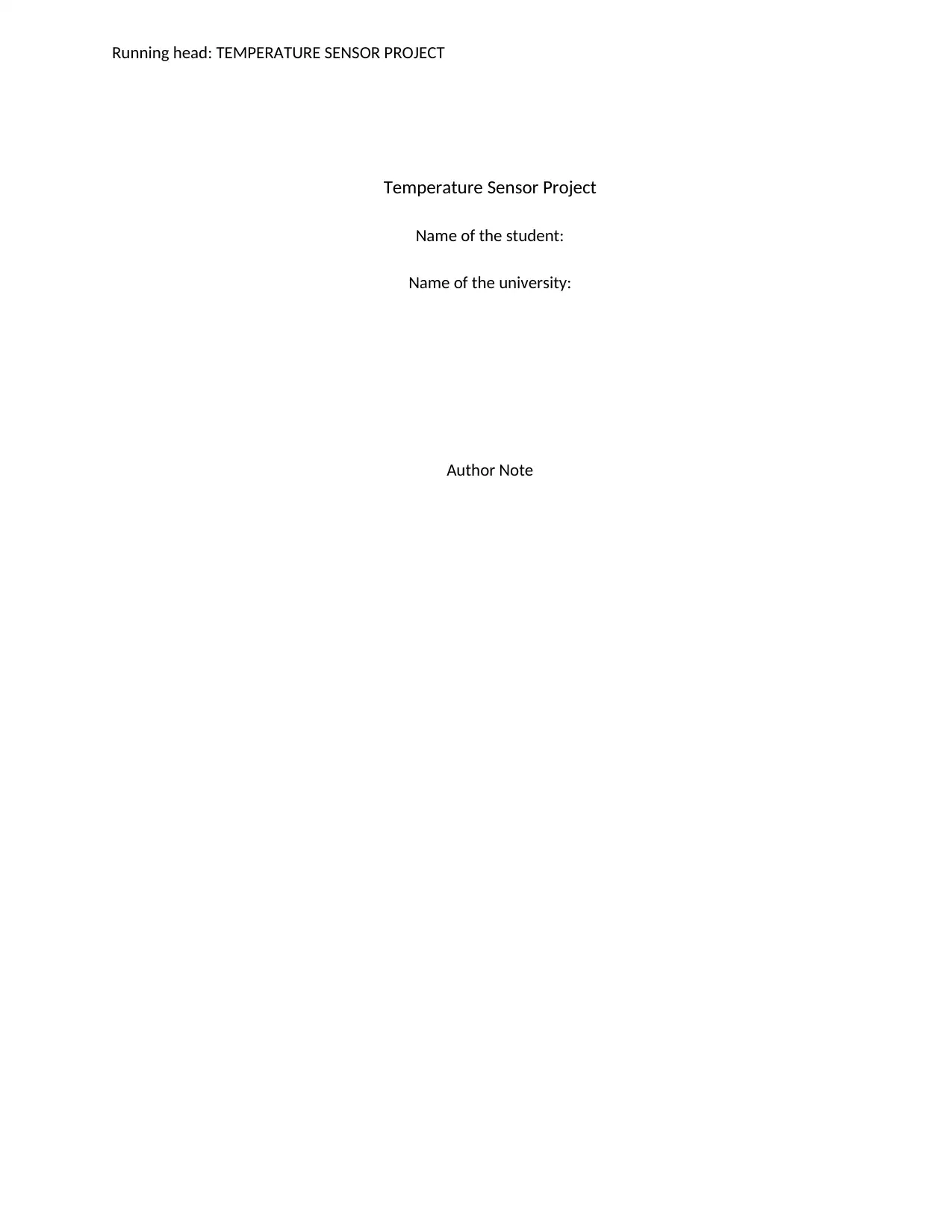
Running head: TEMPERATURE SENSOR PROJECT
Temperature Sensor Project
Name of the student:
Name of the university:
Author Note
Temperature Sensor Project
Name of the student:
Name of the university:
Author Note
Paraphrase This Document
Need a fresh take? Get an instant paraphrase of this document with our AI Paraphraser

1TEMPERATURE SENSOR PROJECT
Abstract
In the following study, a research is conducted on temperature sensors. These sensors are helpful for
detecting proper centigrade temperatures. Various companies of current world have been involved in
extending their sensors to their existing monitoring systems to develop their business.
Abstract
In the following study, a research is conducted on temperature sensors. These sensors are helpful for
detecting proper centigrade temperatures. Various companies of current world have been involved in
extending their sensors to their existing monitoring systems to develop their business.
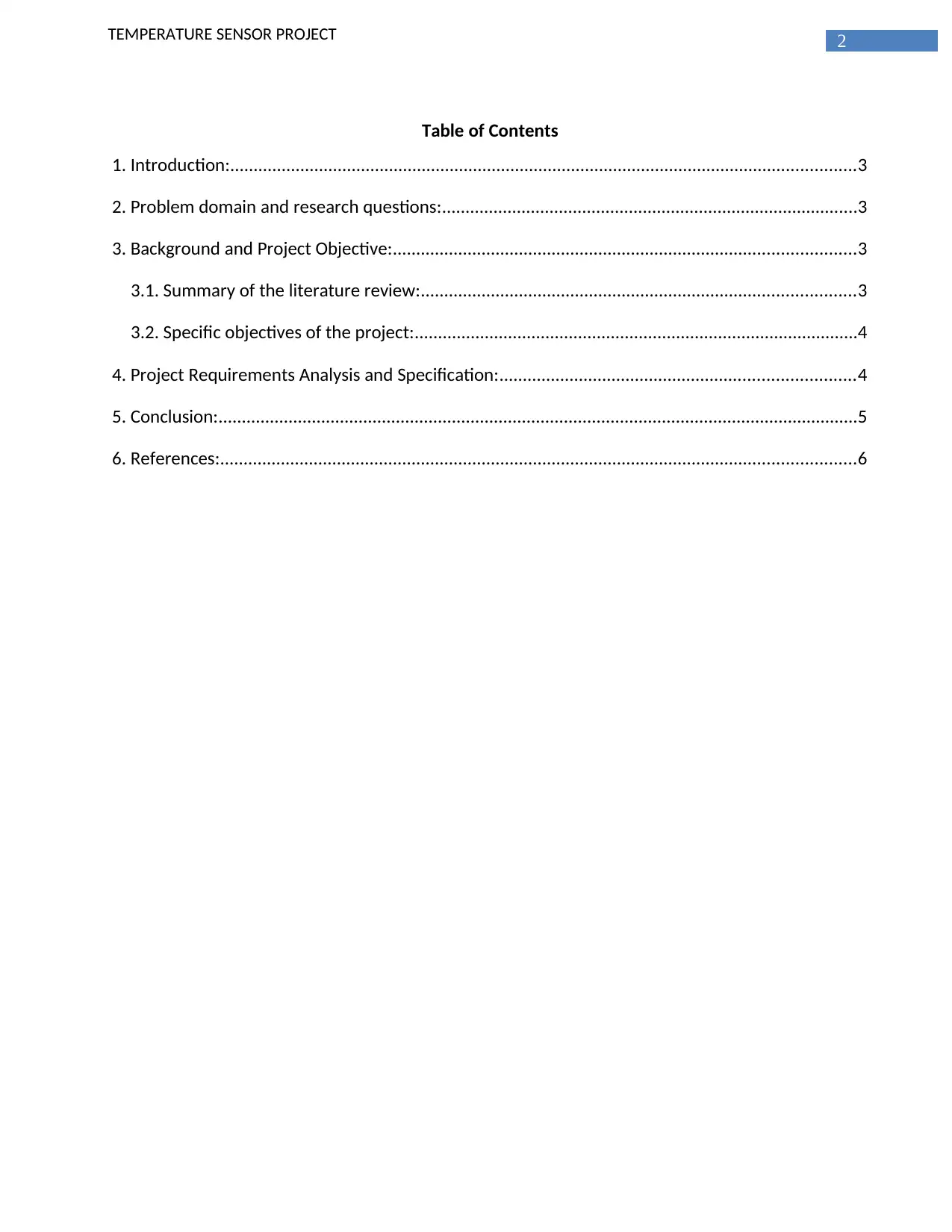
2TEMPERATURE SENSOR PROJECT
Table of Contents
1. Introduction:......................................................................................................................................3
2. Problem domain and research questions:.........................................................................................3
3. Background and Project Objective:...................................................................................................3
3.1. Summary of the literature review:.............................................................................................3
3.2. Specific objectives of the project:...............................................................................................4
4. Project Requirements Analysis and Specification:............................................................................4
5. Conclusion:.........................................................................................................................................5
6. References:........................................................................................................................................6
Table of Contents
1. Introduction:......................................................................................................................................3
2. Problem domain and research questions:.........................................................................................3
3. Background and Project Objective:...................................................................................................3
3.1. Summary of the literature review:.............................................................................................3
3.2. Specific objectives of the project:...............................................................................................4
4. Project Requirements Analysis and Specification:............................................................................4
5. Conclusion:.........................................................................................................................................5
6. References:........................................................................................................................................6
⊘ This is a preview!⊘
Do you want full access?
Subscribe today to unlock all pages.

Trusted by 1+ million students worldwide
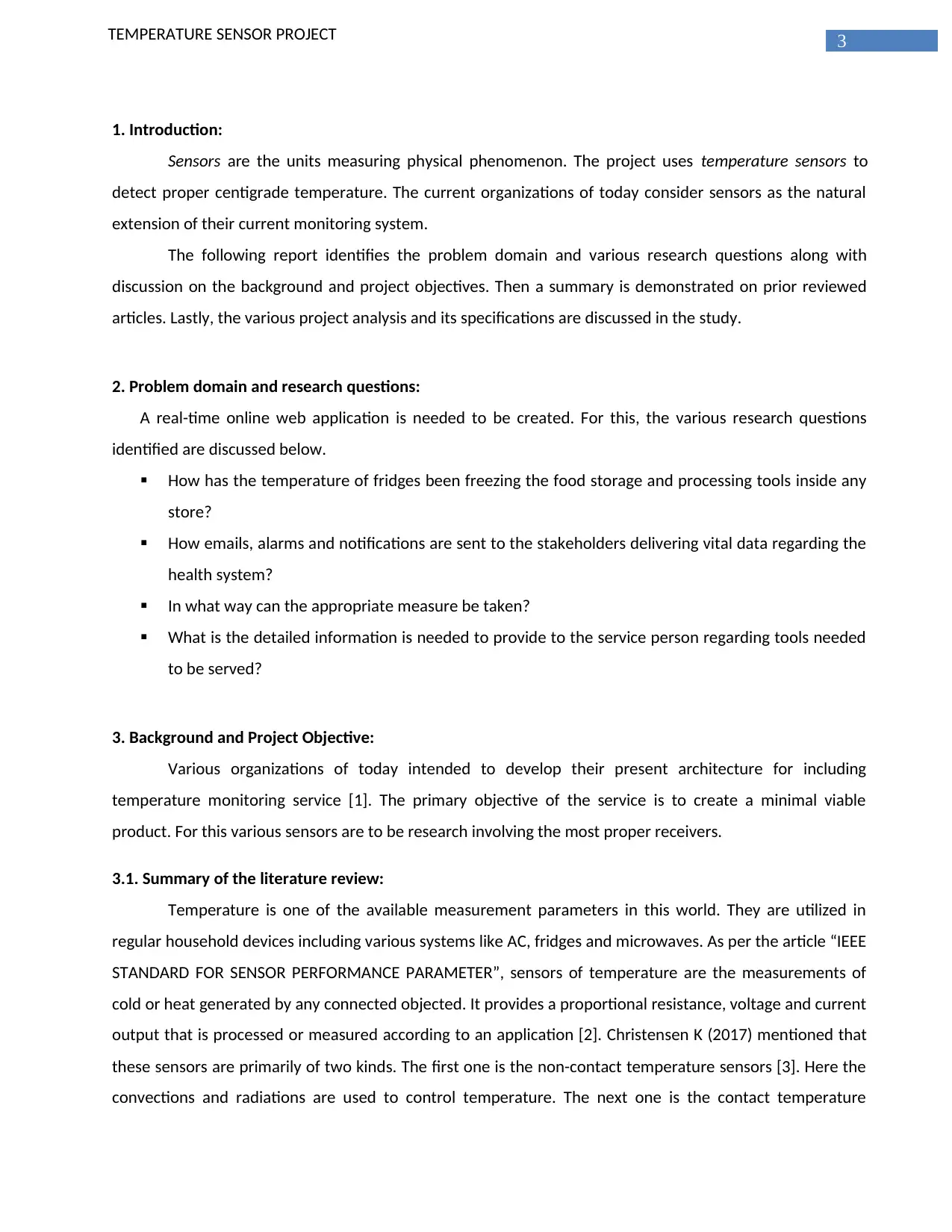
3TEMPERATURE SENSOR PROJECT
1. Introduction:
Sensors are the units measuring physical phenomenon. The project uses temperature sensors to
detect proper centigrade temperature. The current organizations of today consider sensors as the natural
extension of their current monitoring system.
The following report identifies the problem domain and various research questions along with
discussion on the background and project objectives. Then a summary is demonstrated on prior reviewed
articles. Lastly, the various project analysis and its specifications are discussed in the study.
2. Problem domain and research questions:
A real-time online web application is needed to be created. For this, the various research questions
identified are discussed below.
How has the temperature of fridges been freezing the food storage and processing tools inside any
store?
How emails, alarms and notifications are sent to the stakeholders delivering vital data regarding the
health system?
In what way can the appropriate measure be taken?
What is the detailed information is needed to provide to the service person regarding tools needed
to be served?
3. Background and Project Objective:
Various organizations of today intended to develop their present architecture for including
temperature monitoring service [1]. The primary objective of the service is to create a minimal viable
product. For this various sensors are to be research involving the most proper receivers.
3.1. Summary of the literature review:
Temperature is one of the available measurement parameters in this world. They are utilized in
regular household devices including various systems like AC, fridges and microwaves. As per the article “IEEE
STANDARD FOR SENSOR PERFORMANCE PARAMETER”, sensors of temperature are the measurements of
cold or heat generated by any connected objected. It provides a proportional resistance, voltage and current
output that is processed or measured according to an application [2]. Christensen K (2017) mentioned that
these sensors are primarily of two kinds. The first one is the non-contact temperature sensors [3]. Here the
convections and radiations are used to control temperature. The next one is the contact temperature
1. Introduction:
Sensors are the units measuring physical phenomenon. The project uses temperature sensors to
detect proper centigrade temperature. The current organizations of today consider sensors as the natural
extension of their current monitoring system.
The following report identifies the problem domain and various research questions along with
discussion on the background and project objectives. Then a summary is demonstrated on prior reviewed
articles. Lastly, the various project analysis and its specifications are discussed in the study.
2. Problem domain and research questions:
A real-time online web application is needed to be created. For this, the various research questions
identified are discussed below.
How has the temperature of fridges been freezing the food storage and processing tools inside any
store?
How emails, alarms and notifications are sent to the stakeholders delivering vital data regarding the
health system?
In what way can the appropriate measure be taken?
What is the detailed information is needed to provide to the service person regarding tools needed
to be served?
3. Background and Project Objective:
Various organizations of today intended to develop their present architecture for including
temperature monitoring service [1]. The primary objective of the service is to create a minimal viable
product. For this various sensors are to be research involving the most proper receivers.
3.1. Summary of the literature review:
Temperature is one of the available measurement parameters in this world. They are utilized in
regular household devices including various systems like AC, fridges and microwaves. As per the article “IEEE
STANDARD FOR SENSOR PERFORMANCE PARAMETER”, sensors of temperature are the measurements of
cold or heat generated by any connected objected. It provides a proportional resistance, voltage and current
output that is processed or measured according to an application [2]. Christensen K (2017) mentioned that
these sensors are primarily of two kinds. The first one is the non-contact temperature sensors [3]. Here the
convections and radiations are used to control temperature. The next one is the contact temperature
Paraphrase This Document
Need a fresh take? Get an instant paraphrase of this document with our AI Paraphraser
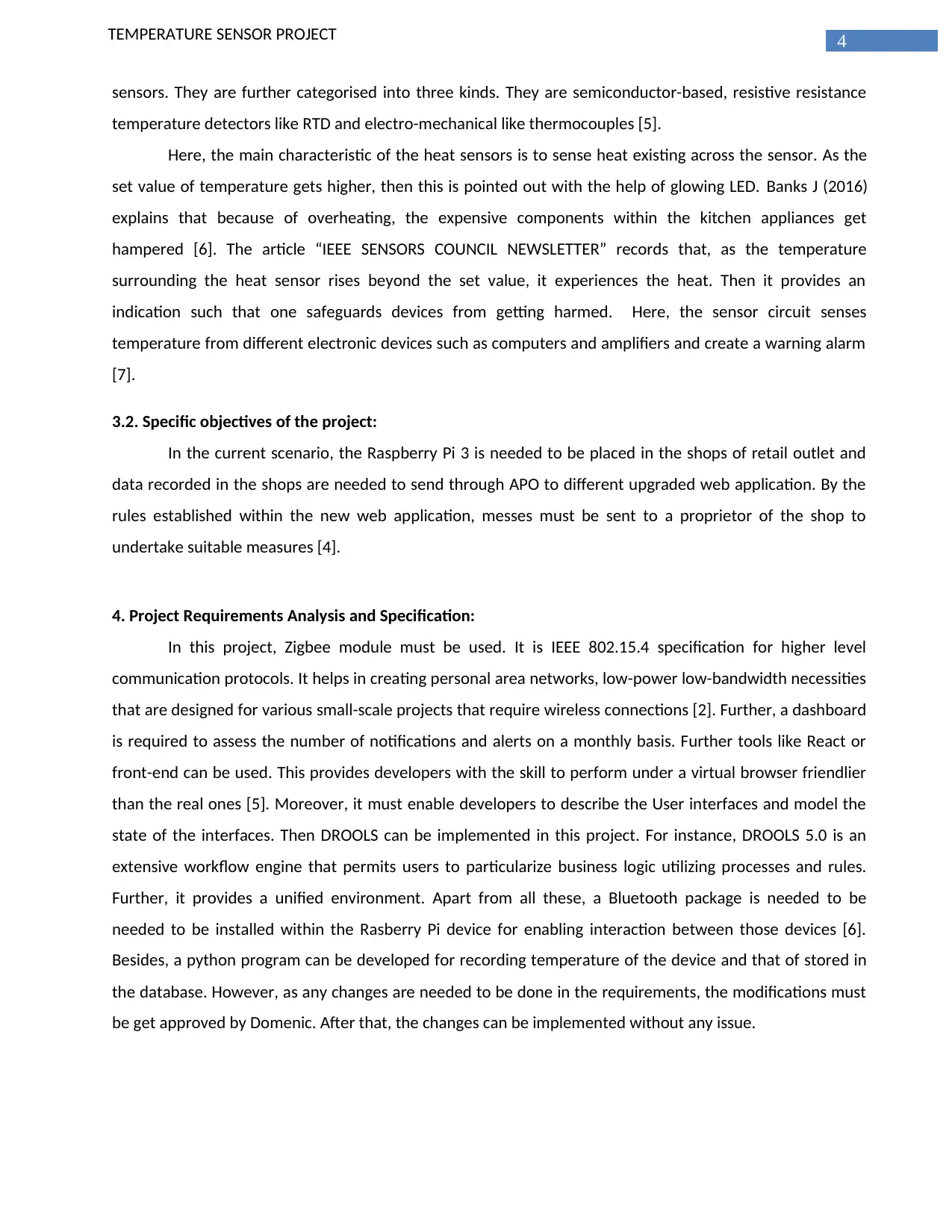
4TEMPERATURE SENSOR PROJECT
sensors. They are further categorised into three kinds. They are semiconductor-based, resistive resistance
temperature detectors like RTD and electro-mechanical like thermocouples [5].
Here, the main characteristic of the heat sensors is to sense heat existing across the sensor. As the
set value of temperature gets higher, then this is pointed out with the help of glowing LED. Banks J (2016)
explains that because of overheating, the expensive components within the kitchen appliances get
hampered [6]. The article “IEEE SENSORS COUNCIL NEWSLETTER” records that, as the temperature
surrounding the heat sensor rises beyond the set value, it experiences the heat. Then it provides an
indication such that one safeguards devices from getting harmed. Here, the sensor circuit senses
temperature from different electronic devices such as computers and amplifiers and create a warning alarm
[7].
3.2. Specific objectives of the project:
In the current scenario, the Raspberry Pi 3 is needed to be placed in the shops of retail outlet and
data recorded in the shops are needed to send through APO to different upgraded web application. By the
rules established within the new web application, messes must be sent to a proprietor of the shop to
undertake suitable measures [4].
4. Project Requirements Analysis and Specification:
In this project, Zigbee module must be used. It is IEEE 802.15.4 specification for higher level
communication protocols. It helps in creating personal area networks, low-power low-bandwidth necessities
that are designed for various small-scale projects that require wireless connections [2]. Further, a dashboard
is required to assess the number of notifications and alerts on a monthly basis. Further tools like React or
front-end can be used. This provides developers with the skill to perform under a virtual browser friendlier
than the real ones [5]. Moreover, it must enable developers to describe the User interfaces and model the
state of the interfaces. Then DROOLS can be implemented in this project. For instance, DROOLS 5.0 is an
extensive workflow engine that permits users to particularize business logic utilizing processes and rules.
Further, it provides a unified environment. Apart from all these, a Bluetooth package is needed to be
needed to be installed within the Rasberry Pi device for enabling interaction between those devices [6].
Besides, a python program can be developed for recording temperature of the device and that of stored in
the database. However, as any changes are needed to be done in the requirements, the modifications must
be get approved by Domenic. After that, the changes can be implemented without any issue.
sensors. They are further categorised into three kinds. They are semiconductor-based, resistive resistance
temperature detectors like RTD and electro-mechanical like thermocouples [5].
Here, the main characteristic of the heat sensors is to sense heat existing across the sensor. As the
set value of temperature gets higher, then this is pointed out with the help of glowing LED. Banks J (2016)
explains that because of overheating, the expensive components within the kitchen appliances get
hampered [6]. The article “IEEE SENSORS COUNCIL NEWSLETTER” records that, as the temperature
surrounding the heat sensor rises beyond the set value, it experiences the heat. Then it provides an
indication such that one safeguards devices from getting harmed. Here, the sensor circuit senses
temperature from different electronic devices such as computers and amplifiers and create a warning alarm
[7].
3.2. Specific objectives of the project:
In the current scenario, the Raspberry Pi 3 is needed to be placed in the shops of retail outlet and
data recorded in the shops are needed to send through APO to different upgraded web application. By the
rules established within the new web application, messes must be sent to a proprietor of the shop to
undertake suitable measures [4].
4. Project Requirements Analysis and Specification:
In this project, Zigbee module must be used. It is IEEE 802.15.4 specification for higher level
communication protocols. It helps in creating personal area networks, low-power low-bandwidth necessities
that are designed for various small-scale projects that require wireless connections [2]. Further, a dashboard
is required to assess the number of notifications and alerts on a monthly basis. Further tools like React or
front-end can be used. This provides developers with the skill to perform under a virtual browser friendlier
than the real ones [5]. Moreover, it must enable developers to describe the User interfaces and model the
state of the interfaces. Then DROOLS can be implemented in this project. For instance, DROOLS 5.0 is an
extensive workflow engine that permits users to particularize business logic utilizing processes and rules.
Further, it provides a unified environment. Apart from all these, a Bluetooth package is needed to be
needed to be installed within the Rasberry Pi device for enabling interaction between those devices [6].
Besides, a python program can be developed for recording temperature of the device and that of stored in
the database. However, as any changes are needed to be done in the requirements, the modifications must
be get approved by Domenic. After that, the changes can be implemented without any issue.
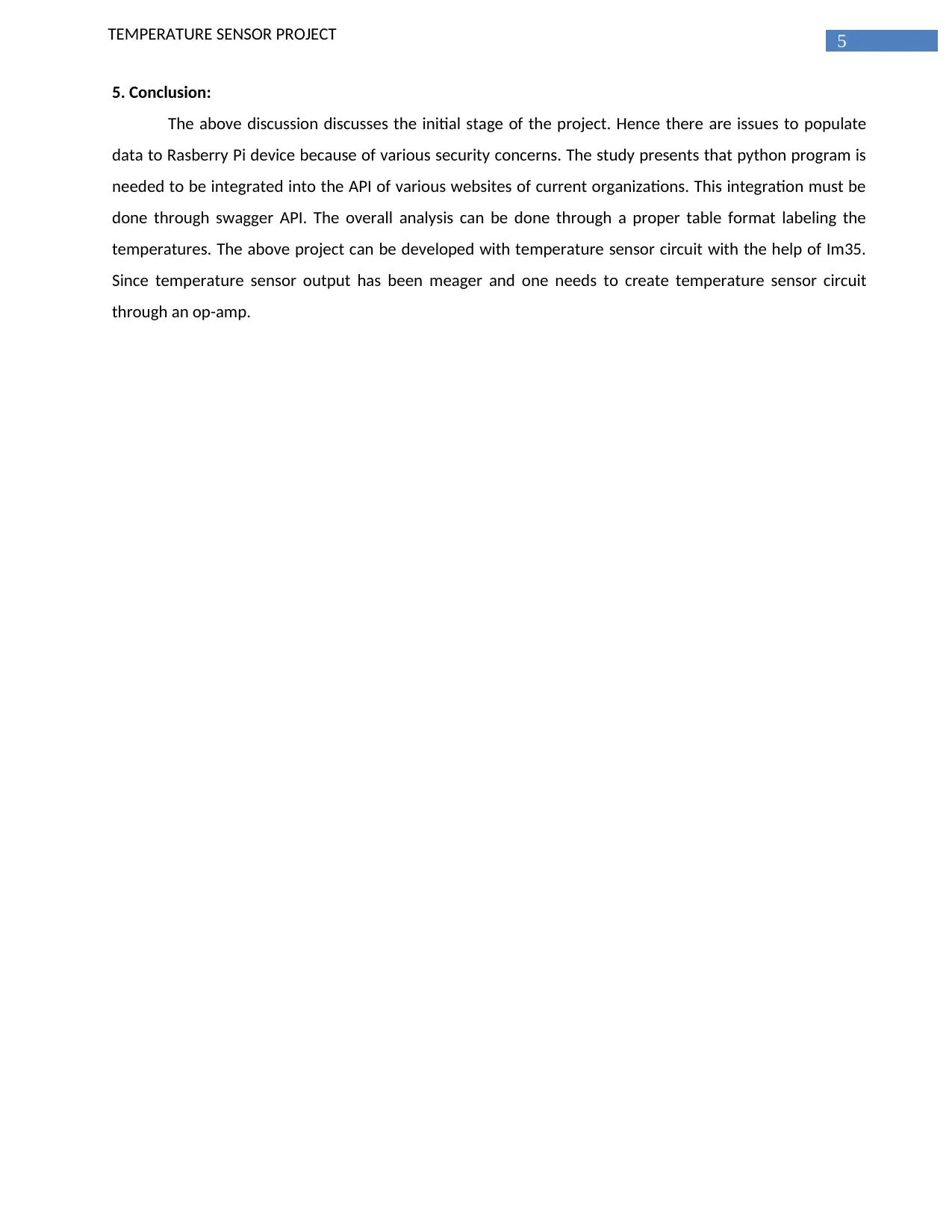
5TEMPERATURE SENSOR PROJECT
5. Conclusion:
The above discussion discusses the initial stage of the project. Hence there are issues to populate
data to Rasberry Pi device because of various security concerns. The study presents that python program is
needed to be integrated into the API of various websites of current organizations. This integration must be
done through swagger API. The overall analysis can be done through a proper table format labeling the
temperatures. The above project can be developed with temperature sensor circuit with the help of Im35.
Since temperature sensor output has been meager and one needs to create temperature sensor circuit
through an op-amp.
5. Conclusion:
The above discussion discusses the initial stage of the project. Hence there are issues to populate
data to Rasberry Pi device because of various security concerns. The study presents that python program is
needed to be integrated into the API of various websites of current organizations. This integration must be
done through swagger API. The overall analysis can be done through a proper table format labeling the
temperatures. The above project can be developed with temperature sensor circuit with the help of Im35.
Since temperature sensor output has been meager and one needs to create temperature sensor circuit
through an op-amp.
⊘ This is a preview!⊘
Do you want full access?
Subscribe today to unlock all pages.

Trusted by 1+ million students worldwide
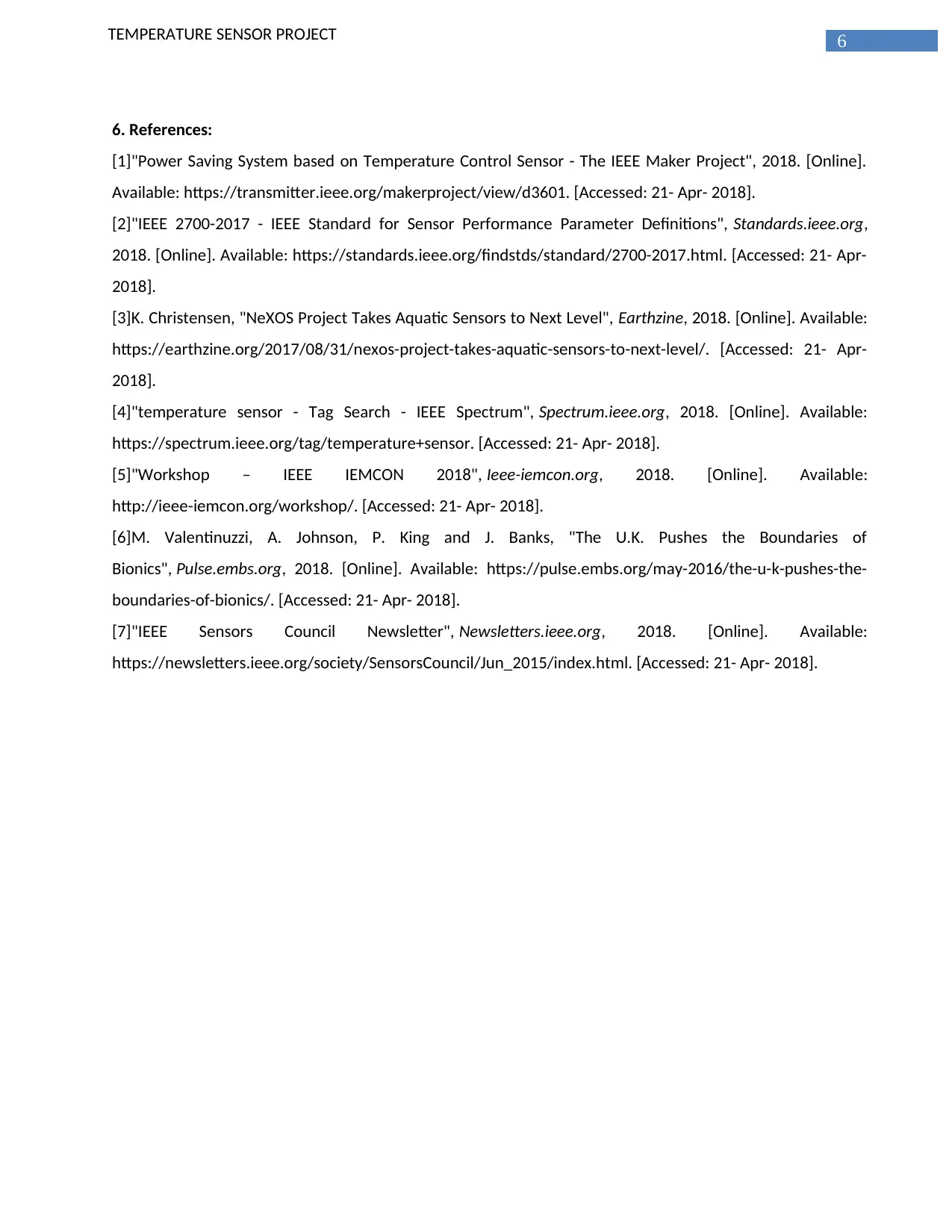
6TEMPERATURE SENSOR PROJECT
6. References:
[1]"Power Saving System based on Temperature Control Sensor - The IEEE Maker Project", 2018. [Online].
Available: https://transmitter.ieee.org/makerproject/view/d3601. [Accessed: 21- Apr- 2018].
[2]"IEEE 2700-2017 - IEEE Standard for Sensor Performance Parameter Definitions", Standards.ieee.org,
2018. [Online]. Available: https://standards.ieee.org/findstds/standard/2700-2017.html. [Accessed: 21- Apr-
2018].
[3]K. Christensen, "NeXOS Project Takes Aquatic Sensors to Next Level", Earthzine, 2018. [Online]. Available:
https://earthzine.org/2017/08/31/nexos-project-takes-aquatic-sensors-to-next-level/. [Accessed: 21- Apr-
2018].
[4]"temperature sensor - Tag Search - IEEE Spectrum", Spectrum.ieee.org, 2018. [Online]. Available:
https://spectrum.ieee.org/tag/temperature+sensor. [Accessed: 21- Apr- 2018].
[5]"Workshop – IEEE IEMCON 2018", Ieee-iemcon.org, 2018. [Online]. Available:
http://ieee-iemcon.org/workshop/. [Accessed: 21- Apr- 2018].
[6]M. Valentinuzzi, A. Johnson, P. King and J. Banks, "The U.K. Pushes the Boundaries of
Bionics", Pulse.embs.org, 2018. [Online]. Available: https://pulse.embs.org/may-2016/the-u-k-pushes-the-
boundaries-of-bionics/. [Accessed: 21- Apr- 2018].
[7]"IEEE Sensors Council Newsletter", Newsletters.ieee.org, 2018. [Online]. Available:
https://newsletters.ieee.org/society/SensorsCouncil/Jun_2015/index.html. [Accessed: 21- Apr- 2018].
6. References:
[1]"Power Saving System based on Temperature Control Sensor - The IEEE Maker Project", 2018. [Online].
Available: https://transmitter.ieee.org/makerproject/view/d3601. [Accessed: 21- Apr- 2018].
[2]"IEEE 2700-2017 - IEEE Standard for Sensor Performance Parameter Definitions", Standards.ieee.org,
2018. [Online]. Available: https://standards.ieee.org/findstds/standard/2700-2017.html. [Accessed: 21- Apr-
2018].
[3]K. Christensen, "NeXOS Project Takes Aquatic Sensors to Next Level", Earthzine, 2018. [Online]. Available:
https://earthzine.org/2017/08/31/nexos-project-takes-aquatic-sensors-to-next-level/. [Accessed: 21- Apr-
2018].
[4]"temperature sensor - Tag Search - IEEE Spectrum", Spectrum.ieee.org, 2018. [Online]. Available:
https://spectrum.ieee.org/tag/temperature+sensor. [Accessed: 21- Apr- 2018].
[5]"Workshop – IEEE IEMCON 2018", Ieee-iemcon.org, 2018. [Online]. Available:
http://ieee-iemcon.org/workshop/. [Accessed: 21- Apr- 2018].
[6]M. Valentinuzzi, A. Johnson, P. King and J. Banks, "The U.K. Pushes the Boundaries of
Bionics", Pulse.embs.org, 2018. [Online]. Available: https://pulse.embs.org/may-2016/the-u-k-pushes-the-
boundaries-of-bionics/. [Accessed: 21- Apr- 2018].
[7]"IEEE Sensors Council Newsletter", Newsletters.ieee.org, 2018. [Online]. Available:
https://newsletters.ieee.org/society/SensorsCouncil/Jun_2015/index.html. [Accessed: 21- Apr- 2018].
1 out of 7
Related Documents
Your All-in-One AI-Powered Toolkit for Academic Success.
+13062052269
info@desklib.com
Available 24*7 on WhatsApp / Email
![[object Object]](/_next/static/media/star-bottom.7253800d.svg)
Unlock your academic potential
Copyright © 2020–2025 A2Z Services. All Rights Reserved. Developed and managed by ZUCOL.





